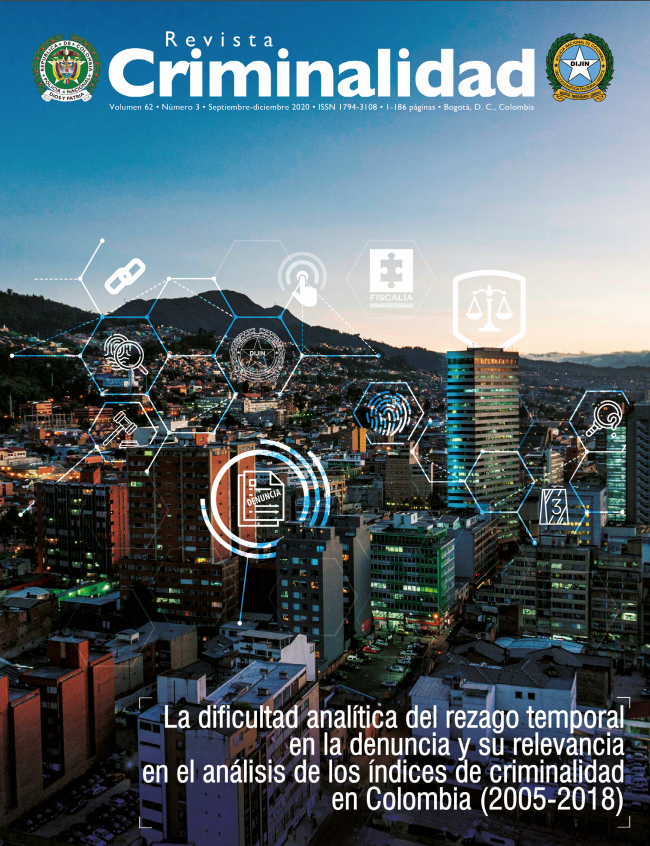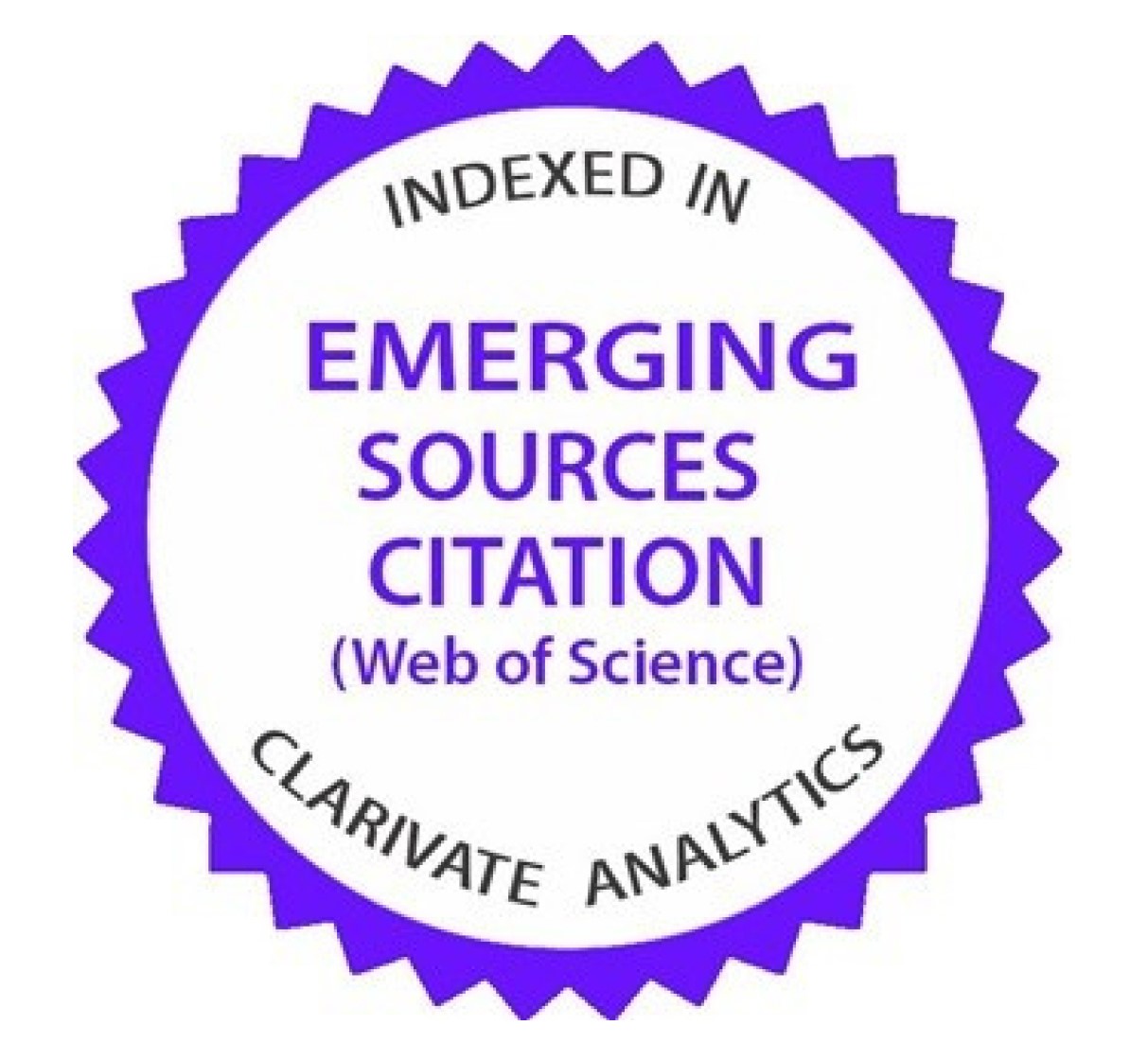Por que os crimes contra o patrimônio são denunciados à polícia? Uma avaliação empírica para o Peru
DOI:
https://doi.org/10.47741/17943108.219Palavras-chave:
cirme contra patrimônio econômico, crime contra patrimônio econômico, denúncia, denúncia, furto, furto, roubo, roubo, vitimização, vitimizaçãoResumo
O Peru não apenas tem uma das taxas mais altas de vitimização em América Latina (24%), mas também a mais baixa em crimes denunciados (15%) (Latinobarómetro, 2016). Neste trabalho, o objetivo foi identificar as características do crime e as características individuais que predizem a decisão de denunciar quatro diferentes crimes patrimoniais (furto de casa, carro, autopeças e motocicleta). Para isso, foram utilizados sete anos de dados de uma pesquisa domiciliar nacional no Peru (2010-2016). As estimativas foram feitas usando regressão logística multinível de efeitos mistos a fim de controlar as características ambientais que também influenciam na decisão de denunciar. O uso de arma de fogo pelo delinquente é o fator que aumenta em maior proporção a probabilidade de denúncia de qualquer um dos quatro crimes avaliados. A vitimização repetida também é um indicador importante, embora para menos crimes. A confiança na polícia não está associada à decisão de denunciar. Este estudo é o primeiro a analisar quantitativamente os fatores que afetam a decisão de denunciar no Peru. Seus resultados são úteis para um melhor entendimento da taxa baixa de denúncias no país.
Downloads
Referências
Aboal, D., Campanella, J. y Lanzilotta, B. (2013). Los costos del crimen en Uruguay (IDB Working Paper Series).
Baumer, E. P. (2002). Neighborhood Disadvantage and Police Notification By Victims of Violence*. Criminology, 40(3), 579-616. https://doi.org/10.1111/j.1745-9125.2002.tb00967.x
Baumer, E. P. y Lauritsen, J. L. (2010). Reporting crime to the police, 1972-2005: A multivariate mnalysis of long-term trends in the National Crime Survery (NCS) and National Crime Victimization Survey (NCVS). Criminology, 48(1), 131-185. https://doi.org/10.1111/j.1745-9125.2010.00182.x
Benavente, J. M. y Cortés, E. (2006). Delitos y sus denuncias. La cifra negra de la criminalidad en Chile y sus determinantes. Serie Documentos de Trabajo, 228(1), 21.
Bennett, R. R. y Wiegand, R. B. (1994). Observations on Crime Reporting in a Developing Nation. Criminology, 32(1), 135-148. https://doi.org/10.1111/j.1745-9125.1994.tb01149.x
Black, D. J. (1973). The Mobilization of Law. The Journal of Legal Studies, 2(1), 125-149. https://doi.org/10.1086/467494
Boateng, F. D. (2016). Crime Reporting Behavior: Do Attitudes towards the Police Matter? Journal of Interpersonal Violence, 33(18), 2891-2916. https://doi.org/10.1177/0886260516632356
Bowles, R., García Reyes, M. y Garoupa, N. (2009). Crime Reporting Decisions and the Cost of Crime. European Journal of Crime Policy Research, 15(4), 365-77. https://doi.org/10.1007/s10610-009-9109-8
Carr, P. J., Napolitano, L. y Keating, J. (2007). We never call the cops and here is why: A qualitative examination of legal cynicism in three Philadelphia neighborhoods. Criminology, 45(2), 445-480. https://doi.org/10.1111/j.1745-9125.2007.00084.x
Chenery, S., Holt, J., y Pease, K. (1997). Biting Back II: Reducing Repeat Victimisation in Huddersfield. In B. Webb (Ed.). Crime Detection and Prevention Series Paper 82. London: Police Research Group.
Colomer, J. L. G. (2018). Policía Judicial: a la búsqueda de un modelo adecuado para una lucha eficaz contra el crimen. Cuadernos de Derecho Penal, 19, 11-46. https://doi.org/10.22518/20271743.1021
Dammert, L. (2018). Construir cuidad en contextos de alta violencia: ¿es posible? El caso del Distrito Central de Honduras. Revista Criminalidad, 60(3): 177-193.
De Ávila, W. M., & Mejía, W. B. (2019). Victimización por crimen, percepción de seguridad y satisfacción con la vida en Colombia. Revista de Economía Institucional, 21(41), 133-160. https://doi.org/10.18601/01245996.v21n41.06
Felson, R. B., Messner, S. F., Hoskin, A. W. y Dean, G. (2002). Reasons for Reporting and Not Reporting Domestic Violence To the Police. Criminology, 40(3), 617-648. https://doi.org/10.1111/j.1745-9125.2002.tb00968.x
Finkelhor, D., & Ormrod, R. (1999). Reporting Crimes Against Juveniles. In S. Bilchik (Ed.). Juvenile Justice Bulletin. Washington DC: US Department of Justice. https://doi.org/10.1037/e406792005-001
García-Sánchez, I.-M., Rodríguez-Domínguez, L., y Parra-Domínguez, J. (2011). Yearly evolution of police efficiency in Spain and explanatory factors. Central European Journal of Operations Research, 21, 31-62. https://doi.org/10.1007/s10100-011-0207-6
García, A. (2013). Factorías del crimen: México y Colombia, oleadas o persistencia de la violencia. Sociología Histórica, 2, 355-380.
Gingerich, D. W. y Oliveros, V. (2018). Police Violence and the Underreporting of Crime. Economics and Politics, 30(1), 78-105. https://doi.org/10.1111/ecpo.12102
Goldstein, H. (2010). Multilevel statistical models. West Sussex: Wiley. https://doi.org/10.1002/9780470973394
Gottfredson, D. M. y Hindelang, M. J. (1979). A Study of the Behavior of Law. American Sociological Review, 44(1), 3-18. https://doi.org/10.2307/2094813
Gottfredson, M. R., y Gottfredson, D. M. (1988). Decision Making in Criminal Justice: Toward the Rational Exercise of Discretion. New York City: Plenum Press. https://doi.org/10.1007/978-1-4757-9954-5
Goudriaan, H., Wittebrood, K. y Nieuwbeerta, P. (2006). Neighbourhood Characteristics and Reporting Crime. The British Journal of Criminology, 46(4), 719-742. https://doi.org/10.1093/bjc/azi096
Greenberg, M. S. y Beach, S. R. (2004). Property crime victims’ decision to notify the police: Social, cognitive, and affective determinants. Law and Human Behavior, 28(2), 177-186. https://doi.org/10.1023/B:LAHU.0000022321.19983.ea
Gutiérrez, C. M. y Kirk, D. S. (2017). Silence Speaks: The Relationship between Immigration and the Underreporting of Crime. Crime and Delinquency, 63(8), 926-950. https://doi.org/10.1177/0011128715599993
Hindelang, M. J., y Gottfredson, D. M. (1976). The Victim’s Decision not to Invoke the Criminal Justice Process. In W. McDonald (Ed.), Criminal Justice and the Victim (pp. 15-46). Beverly Hills: Sage.
Instituto Nacional de Estadística e Informática. (2007). Censo Nacional de Población y Vivienda. Lima: Instituto Nacional de Estadística e Informática.
Instituto Nacional de Estadística e Informática. (2016a). Censo de Comisarías. Lima:
Instituto Nacional de Estadística e Informática. Instituto Nacional de Estadística e Informática. (2016b). Encuesta Nacional de Programas Estratégicos. Lima: Instituto Nacional de Estadística e Informática.
Instituto Nacional de Estadística e Informática. (2016c). Registro Nacional de Municipalidades. Lima: Instituto Nacional de Estadística e Informática.
Jackson, J., Bradford, B., Hough, M. y Murray, K. (2012). Compliance with the law and policing by consent: Notes on police and legal legitimacy. In A. Crawford y A. Hucklesby (Eds.). Legitimacy and Compliance in Criminal Justice, (pp. 29-49). https://doi.org/10.4324/9780203113998
Kääriäinen, J. T. (2007). Trust in the police in 16 European countries: A multilevel analysis. European Journal of Criminology, 4(4), 409-435. https://doi.org/10.1177/1477370807080720
Kääriäinen, J. T. y Sirén, R. (2011). Trust in the police, generalized trust and reporting crime. European Journal of Criminology, 8(1), 65-81. https://doi.org/10.1177/1477370810376562
Khondaker, M. I., Wu, Y. y Lambert, E. G. (2017). Bangladeshi immigrants’ willingness to report crime in New York City. Policing and Society, 27(2), 188-204. https://doi.org/10.1080/10439463.2015.1040795
Kirk, D. S. y Matsuda, M. (2011). Legal Cynicism, Collective Efficacy, And The Ecology Of Arrest. Criminology, 49(2), 443-472. https://doi.org/10.1111/j.1745-9125.2011.00226.x
Kochel, T. R., Parks, R. y Mastrofski, S. D. (2013). Examining Police Effectiveness as a Precursor to Legitimacy and Cooperation with Police. Justice Quarterly, 30(5), 895-925. https://doi.org/10.1080/07418825.2011.633544
Kuo, S. Y., Cuvelier, S. J., Sheu, C. J. y Chang, K. M. (2012). Crime reporting behavior and black’s behavior of law. International Sociology, 27(1), 51-71. https://doi.org/10.1177/0268580911423054
Kury, H., Teske, R. H. C. y Würger, M. (1999). Reporting of crime to the police in the federal republic of Germany: A comparison of the old and the new lands. Justice Quarterly, 16(1), 123-151. https://doi.org/10.1080/07418829900094081
Landau, T. C. (2006). Challenging Notions. Critical Victimology in Canada. Toronto: Canadian Scholars Press.
Latinobarómetro. (2015). Informe Latinobarómetro 1995-2015. Recuperado de http://americanuestra.com/wp-content/uploads/2015/09/INFORMELB-2015-3.pdf
Latinobarómetro. (2016). Informe Latinobarómetro 2016. Santiago de Chile. https://www.latinobarometro.org/LATDocs/F00005843-Informe_LB_2016.pdf
Levitt, S. y Rubio, M. (2002). Crimen en Colombia: análisis y sugerencias de política. En A. Alesina (Ed.). Reformas Institucionales en Colombia (pp. 55-94). Bogotá: Fedesarrollo, Alfaomega.
Maguire, E., Shin, Y., Zhao, J., y Hassell, K. (2003). Structural change in large police agencies during the 1990s. Policing An International Journal of Police Strategies and Management, 26(2), 251-275. https://doi.org/10.1108/13639510310475750
Mancera, A. (2010). Factores socioeconómicos y demográficos de distintas categorías de delitos en Colombia: Prueba desde un panel de datos de las regiones de Colombia. Revista de Economía del Caribe, 2, 202-231.
Ortega, D., Mejía, D. y Ortiz, K. (2015). Un análisis de la criminalidad urbana en Colombia (Documento de Trabajo N 2015/06).
Posick, C. (2014). Victimization and reporting to the police: The role of negative emotionality. Psychology of Violence, 4(2), 210-223. https://doi.org/10.1037/a0031770
Reyns, B. W., y Randa, R. (2017). Victim Reporting Behaviors Following Identity Theft Victimization: Results From the National Crime Victimization Survey. Crime and Delinquency, 63(7), 814-838. https://doi.org/10.1177/0011128715620428
Rodríguez-Ortega, J.D., Mejía-Londoño, D., CaroZambrano, L., Romero-Hernández, M., y Campos-Méndez, F. (2018). Implicaciones del proceso de integración de los registros administrativos de criminalidad entre el SPOA de la Fiscalía General y el SIEDCO de la Policía Nacional de Colombia, y la puesta en marcha del aplicativo “¡ADenunciar!” sobre las cifras de criminalidad. Revista Criminalidad, 60(3), 9-27. http://www.scielo.org.co/scielo.php?script=sci_arttext&pid=S1794-31082018000300009&lng=en&tlng=
Skogan, W. G. (1984). Reporting crimes to the police: The status of world research. Journal of Research in Crime and Delinquency, 21(2), 113-137. https://doi.org/10.1177/0022427884021002003
Skogan, W. G. (2009). Concern about crime and confidence in the police: Reassurance or accountability? Police Quarterly, 12(3), 301-318. https://doi.org/10.1177/1098611109339893
Smith, R. y Somerville, P. (2013). The long goodbye: A note on the closure of rural police stations and the decline of rural policing in Britain. Policing: An International Journal of Police Strategies & Management Measuring, 7(4), 348-358. https://doi.org/10.1093/police/pat031
Soares, R. R. (2004). Crime Reporting as a Measure of Institutional Development. Economic Development and Cultural Change, 52(4), 851-871. https://doi.org/10.1086/420900
Tankebe, J. (2010). Public confidence in the police: Testing the effects of public experiences of police corruption in Ghana. British Journal of Criminology, 50(2), 296-319. https://doi.org/10.1093/bjc/azq001
Tarling, R. y Morris, K. (2010). Reporting crime to the police. British Journal of Criminology, 50(3), 474-490. https://doi.org/10.1093/bjc/azq011
Tolsma, J., Blaauw, J. y te Grotenhuis, M. (2012). When do people report crime to the police? Results from a factorial survey design in the Netherlands, 2010. Journal of Experimental Criminology, 8(2), 117-134. https://doi.org/10.1007/s11292-011-9138-4
Tyler, T. R. y Jackson, J. (2014). Popular legitimacy and the exercise of legal authority: Motivating compliance, cooperation, and engagement. Psychology, Public Policy and Law, 20(1), 78-95. https://doi.org/10.1037/a0034514
Ungar, M. (2011). Policing Democracy: Overcoming obstacles to citizen security in Latin America. Washingtong DC: Johns Hopkins University Press.
UNODC. (2016). Economic and Social Council United Nations Office on Drugs and Crime (UNODC). Commission on Crime Prevention and Criminal Justice, 21347(March), 1-20. https://doi.org/10.1017/S0020818300011322
Warner, B. D. (1992). The Reporting of Crime: A Missing Link in Conflict Theory. In A. E. Liska (Ed.), Social Threat and Social Control (pp. 71-88). New York City: State University of New York Press.
Watkins, A. M. (2005). Examining the disparity between juvenile and adult victims in notifying the police: A study of mediating variables. Journal of Research in Crime and Delinquency, 42(3), 333-353. https://doi.org/10.1177/0022427805275186
Woltman, H., Feldstain, A., MacKay, C. y Rocchi, M. (2012). An introduction to hierarchical linear modeling. Tutorials for Quantitative Methods for Psychology, 8(1), 52-69. https://doi.org/10.20982/tqmp.08.1.p052
Zhang, L., Messner, S. F. y Liu, J. (2007). An exploration of the determinants of reporting crime to the police in the city of Tianjin, China. Criminology, 45(4), 959-984. https://doi.org/10.1111/j.1745-9125.2007.00093.x
Zweig, J. y Yahner, J. (2013). Providing Services to Victims of Crime. In R. C. Davis, A. J. Lurigio, y S. Herman (Eds.), Victims of Crime (4th ed., pp. 325-348). Washington DC: Sage.
Publicado
Como Citar
Edição
Seção
Licença
Licencia creative commons CC BY NC ND https://creativecommons.org/licenses/by-nc-nd/2.0/















